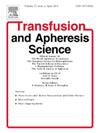网织红细胞血红蛋白:一个有用的工具,检测猖獗的缺铁状态在定期女性献血者。
IF 1.2
4区 医学
Q4 HEMATOLOGY
引用次数: 0
摘要
背景和目的:定期献血者有发生潜在铁缺乏症(LID)的风险,最常见于女性献血者。尽管在某些人群中女性献血者多于男性,但潜在的铁缺乏可能会限制年轻女性定期献血的能力。目前的献血者选择指南只筛查捐献前的血红蛋白水平,可能会遗漏那些有LID的人,这会导致后来明显的缺铁。诊断LID的金标准是血清转铁蛋白受体水平(sTfR)。然而,由于它的高成本,它可能不是一种实用的筛选工具。因此,本研究旨在发现网织红细胞血红蛋白(Ret-He)在检测LID中的作用,并将其与定期献血者的血清铁蛋白进行比较。方法:该研究包括161名同意参加研究的女性定期献血者。根据sTfR水平将受试者分为LID组和non-LID组。比较两组间Ret-He及血清铁蛋白水平。结果:研究发现,在定期女性献血者中,LID献血者占37.25 %。LID供者的Ret-He水平(25.6 ± 1.54 pg/dL)明显低于非LID供者(27.9 ± 1.49 pg/dL)。Ret-He的敏感性(83.3 %)和特异性(85.1 %)均高于血清铁蛋白。结论:LID在女性定期献血者中高发。Ret-He可作为女性定期献血者铁状态的筛查工具,从而防止因捐献而明显缺铁。本文章由计算机程序翻译,如有差异,请以英文原文为准。
Reticulocyte hemoglobin: A useful tool for detecting rampant iron-deficient state in regular female blood donors
Background and objective
Regular blood donors are at risk of developing Latent Iron Deficiency (LID), most commonly seen in female blood donors. Although female blood donors outnumber males in some populations, latent iron deficiency may limit the ability of young females to donate regularly. Current blood donor selection guidelines only screen for pre-donation hemoglobin levels, potentially missing those with LID, which leads to overt iron deficiency later. The gold standard for diagnosing LID is serum transferrin receptor level (sTfR). However, it may not be practical as a screening tool due to its high cost. Therefore, the present study aimed to find the utility of Reticulocyte Hemoglobin (Ret-He) in detecting LID and compare it with serum ferritin among regular female blood donors.
Methods
The study included 161 female regular blood donors who consented to participate in the study. Subjects were divided into two groups- LID and non-LID based on sTfR levels. Ret-He and Serum ferritin levels were compared between the two groups.
Results
The study found 37.25 % of LID donors among regular female blood donors. Donors with LID had significantly lower mean Ret-He levels (25.6 ± 1.54 pg/dL) than non-LID donors (27.9 ± 1.49 pg/dL). Also, Ret-He had higher sensitivity (83.3 %) and specificity (85.1 %) than serum ferritin.
Conclusion
LID is highly prevalent among regular female blood donors. Ret-He can be used as a screening tool for iron status in female regular blood donors, thus preventing overt iron deficiency due to donation.
求助全文
通过发布文献求助,成功后即可免费获取论文全文。
去求助
来源期刊
CiteScore
3.60
自引率
5.30%
发文量
181
审稿时长
42 days
期刊介绍:
Transfusion and Apheresis Science brings comprehensive and up-to-date information to physicians and health care professionals involved in the rapidly changing fields of transfusion medicine, hemostasis and apheresis. The journal presents original articles relating to scientific and clinical studies in the areas of immunohematology, transfusion practice, bleeding and thrombotic disorders and both therapeutic and donor apheresis including hematopoietic stem cells. Topics covered include the collection and processing of blood, compatibility testing and guidelines for the use of blood products, as well as screening for and transmission of blood-borne diseases. All areas of apheresis - therapeutic and collection - are also addressed. We would like to specifically encourage allied health professionals in this area to submit manuscripts that relate to improved patient and donor care, technical aspects and educational issues.
Transfusion and Apheresis Science features a "Theme" section which includes, in each issue, a group of papers designed to review a specific topic of current importance in transfusion and hemostasis for the discussion of topical issues specific to apheresis and focuses on the operators'' viewpoint. Another section is "What''s Happening" which provides informal reporting of activities in the field. In addition, brief case reports and Letters to the Editor, as well as reviews of meetings and events of general interest, and a listing of recent patents make the journal a complete source of information for practitioners of transfusion, hemostasis and apheresis science. Immediate dissemination of important information is ensured by the commitment of Transfusion and Apheresis Science to rapid publication of both symposia and submitted papers.

 求助内容:
求助内容: 应助结果提醒方式:
应助结果提醒方式:


